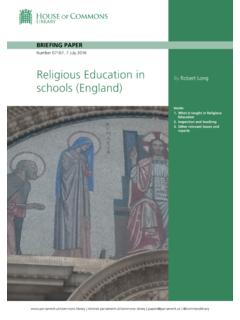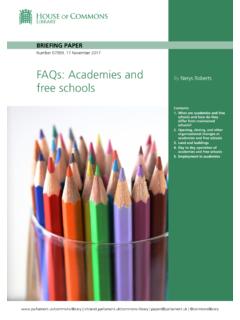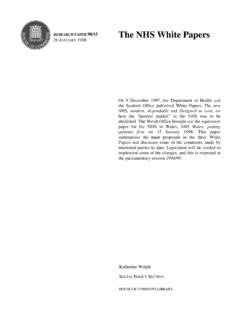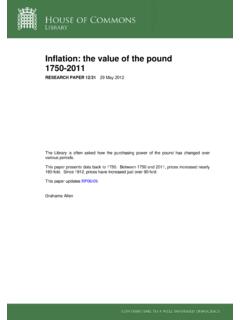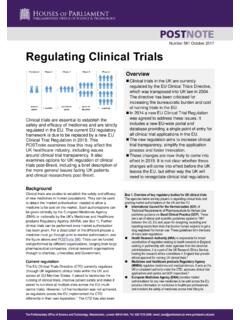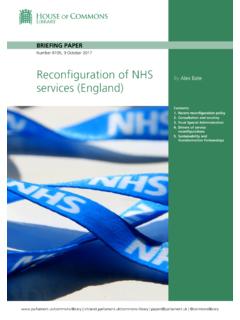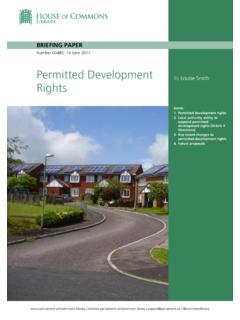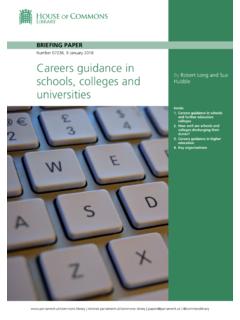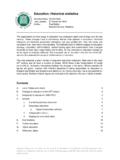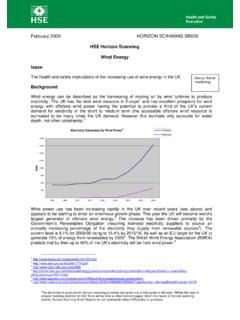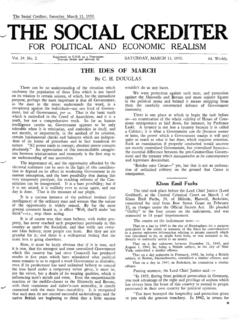Transcription of The Separation of Powers
1 The Separation of Powers Standard Note: SN/PC/06053 Last updated: 15 August Author: Richard Benwell and Oonagh Gay Section Parliament and Constitution Centre Separation of Powers refers to the idea that the major institutions of state should be functionally independent and that no individual should have Powers that span these offices. The principal institutions are usually taken to be the executive, the legislature and the judiciary. In early accounts, such as Montesquieu s The Spirit of the Laws, the Separation of Powers is intended to guard against tyranny and preserve liberty. It was held that the major institutions should be divided and dependent upon each other so that one power would not be able to exceed that of the other two. Today, the Separation of Powers is more often suggested as a way to foster a system of checks and balances necessary for good government.
2 In the United States and other presidential system, a strict Separation is often a fundamental constitutional principle. In the United Kingdom and other common law jurisdictions, however, the theory of Separation has enjoyed much less prominence. In the UK, the major offices and institutions have evolved to achieve balance between the Crown (and more recently the Government) and Parliament. The system resembles a balance of Powers more than a formal Separation of the three branches, or what Walter Bagehot called a fusion of Powers in The English Constitution. In the last decade the concept of a Separation of Powers has evident in a number of policy initiatives. The previous Government suggested that, in its reforms of the judiciary in the Constitutional Reform Act 2005, it was moving toward a more formal Separation of Powers . The creation of an independent Supreme Court and dismantling of the many-faceted office of Lord Chancellor have unpicked some aspects of the fusion of Powers .
3 Matters have also been complicated by the Human Rights Act 1998 and its requirement for judges to consider the European Convention on Human Rights and the decisions of the European Court of Human Rights in Strasbourg. More recently, the proposed change in the number of Members of Parliament, use of parliamentary privilege and Members involvement in super injunctions have again raised issues of the interaction of the institutions of state. This Standard Note considers the extent to which 1) the executive and legislature; 2) the executive and judiciary; and 3) the judiciary and legislature now overlap and interact. This information is provided to Members of Parliament in support of their parliamentary duties and is not intended to address the specific circumstances of any particular individual. It should not be relied upon as being up to date; the law or policies may have changed since it was last updated; and it should not be relied upon as legal or professional advice or as a substitute for it.
4 A suitably qualified professional should be consulted if specific advice or information is required. This information is provided subject to our general terms and conditions which are available online or may be provided on request in hard copy. Authors are available to discuss the content of this briefing with Members and their staff, but not with the general public. Contents 1 Introduction 2 2 The institutions of state 3 Separation of executive and legislature 3 Legislature and judiciary 5 Parliamentary privilege 6 Sub judice 7 The executive and judiciary 7 3 The Constitutional Reform Act 2005 8 4 Super-Injunctions 10 1 Introduction The doctrine of the Separation of Powers suggests that the principal institutions of state executive, legislature and judiciary should be divided in person and in function in order to safeguard liberties and guard against tyranny.
5 One of the earliest and clearest statements of the Separation of Powers was given by Montesquieu in 1748: When the legislative and executive Powers are united in the same person, or in the same body of magistrates, there can be no there is no liberty if the Powers of judging is not separated from the legislative and there would be an end to everything, if the same man or the same were to exercise those three According to a strict interpretation of the Separation of Powers , none of the three branches may exercise the power of the other, nor should any person be a member of any two of the branches. Instead, the independent action of the separate institutions should create a system of checks and balances between them. The United States Constitution adheres closely to the Separation of Powers . Article I grants Powers to the legislature; article II gives executive power to the President; and article III creates an independent judiciary.
6 Congress is elected separately from the President, who does not sit as part of the legislature. The Supreme Court can declare the acts of both Congress and President to be unconstitutional. In practice, however, many countries do not aim for a strict Separation of Powers , but opt for a compromise, where some functions are shared between the institutions of state. In the UK, the Powers of Parliament, Government and courts are closely intertwined. In fact, the executive and legislature are seen as a close union, [a] nearly complete fusion of the 1 Montesquieu, Charles de Secondat, baron de. The Sprit of Laws ( ). Translated and edited by Anne Cohler, Basia Miller, Harold Stone. (New York: Cambridge University Press, 1989) 2 executive and legislative Powers , which Walter Baghot viewed as the efficient secret of the English constitution .2 Globally, the Separation of Powers has enjoyed very different degrees of implementation.
7 Parliamentary systems of government have usually united legislature and executive for the sake of By contrast, presidential systems tend to be strictly separated. Recently, however, the question of the Separation of Powers has been given new relevance in the UK by the question of constitutional reform and by the new constitutional questions, largely arising from the implementation of European laws such as the Human Rights Act 1998. Professor Vernon Bogdanor has predicted that issues which, in the past, were decided by ministers accountable to Parliament will now come to be decided by the courts .4 This Standard Note sets out the theory of the Separation of Powers and examines its relevance for questions of constitutional reform in the United Kingdom. 2 The institutions of state Typically, the Separation of Powers refers to Montequieu s version of the three main institutions of state, though this is often complicated by different layers of authority, such as the supranational Commission, Council, Parliament and Courts of the European Union.
8 In the UK, the executive comprises the Crown and the Government, including the Prime Minister and Cabinet ministers. The executive formulates and implements policy. The legislature, Parliament, comprises the Crown, the House of Commons and the House of Lords. The judiciary comprises the judges in the courts of law, those who hold judicial office in tribunals and the lay magistrates who staff the magistrates courts. Senior judicial appointments are made by the Crown. Separation of executive and legislature In the UK, and other common law jurisdictions, the executive and legislature are closely entwined. The Prime Minister and a majority of his or her ministers are Members of Parliament and sit in the House of Commons. The executive is therefore present at the heart of Parliament. By contrast, in the USA, the President may not be a member of the legislature (Congress), and is elected separately from congressional elections.
9 This may result in the President being a member of a different political party from the majority of members of Congress. The UK s integration of executive and legislature is said to provide stability and efficiency in the operation of government. It has been described as a system that intentionally promotes efficiency over abstract concerns about tyranny . 5 For example, the Prime Minister is usually both head of the executive branch and leader of the majority party in the legislature, which 2 Bagehot, The English Constitution, 1867, p 67 68 3 Ronald J Krotoszynski, The Separation of legislative and executive Powers in Tom Ginsburg, Rosalind Dixon (eds) Comparative Constitutional Law, Cheltenham: Edward Elgar, 2011, p 234 4 Professor Vernon Bogdanor, Parliament and the Judiciary: The Problem of Accountability , speech to the UK Public Administration Consortium, 9 February 2006.
10 See more generally Vernon Bogdanor the New British Constitution 2009 5 Ronald J Krotoszynski, The Separation of legislative and executive Powers in Tom Ginsburg, Rosalind Dixon (eds) Comparative Constitutional Law, Cheltenham: Edward Elgar, 2011, p 248 3 gives the executive branch much more freedom of action than a president usually enjoys in a presidential system of government. Additionally, Parliament may delegate law-making Powers to the Government through Powers to draft secondary or delegated legislation. This can liberate Parliament from the need to scrutinise small technical details, while maintaining the safeguard of Parliamentary approval. In this way, in the UK legislature and executive are far from separate Powers . On the other hand, the executive presence in Parliament may actually facilitate scrutiny provided that the necessary procedures are in place.
